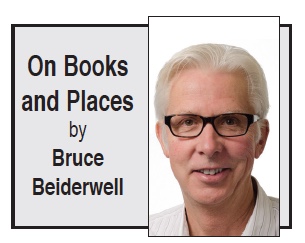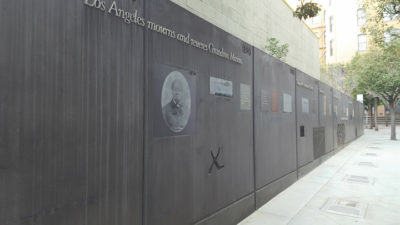On Books and Places: AME founder, former slave honored near Bradbury Building — site she once owned
 Tucked into the neighborhood of the Grand Central Market and the Bradbury Building, the memorial honoring Bridget “Biddy” Mason isn’t a place most people go to. Rather, it’s one they come upon. Set just off Spring Street, it’s a quiet space — at least relative to the bustle surrounding it.
Tucked into the neighborhood of the Grand Central Market and the Bradbury Building, the memorial honoring Bridget “Biddy” Mason isn’t a place most people go to. Rather, it’s one they come upon. Set just off Spring Street, it’s a quiet space — at least relative to the bustle surrounding it.
The main feature of this small park created in 1990 by landscape architects Katherine Spitz and Pamela Burton is a timeline of Biddy Mason’s life — a life that started in Georgia in 1818 and ended in Los Angeles in 1891. The arc of her life stretched from slavery to freedom. The timeline by artist Sheila Levrant de Bretteville, an 80-foot-long poured concrete wall, is titled “Biddy Mason Time and Place.”

MEMORIAL honors life from slavery to freedom. Photo by Jessica Hodgdon/L.A. Conservancy
The crucial turn in Biddy’s life didn’t come easily or early. Biddy was a slave of Robert Smith, a Mississippi man and Mormon convert who in 1848 joined a caravan that traveled 1,700 miles to the Salt Lake Valley. Biddy and other slaves walked every step behind the wagons. Smith, a perpetually unsettled sort, was soon on the road again — with his slaves — 500 miles further west to California. There he grew fearful that he couldn’t keep his human “property,” so he planned yet another move, this time to Texas. Biddy, with help of a small — and free — Black community, refused to go along; she brought legal action. It wasn’t a quick or certain process, but in 1856 Bridget Mason, along with 13 other slaves owned by Smith, were granted freedom.
That history led of course to more history. Biddy gained employment as a skilled midwife and physician’s assistant, proved herself an astute businesswoman, helped establish the First AME Church in Los Angeles, and became a property owner of considerable substance.
The downtown memorial stands upon space Biddy owned at the time of her death. By most accounts, she was the wealthiest African American woman living west of the Mississippi. By all accounts, she used her wealth generously.
It’s tempting to extend the respect expressed by the Biddy Mason Memorial Park to Los Angeles more broadly. After all, it was here Biddy was freed from slavery and here she found opportunity. But the injustices she and others endured should not allow complacent civic self-congratulations. Although it entered the Union as a free state in 1850, California wasn’t then and hasn’t been since free of racism. The new state’s first Chief Justice, an ardent supporter of slavery, was to become an officer in the Confederate army. Legislative efforts early on to completely block Black immigration sent threatening signals to the Black people who were here. And whenever property was perceived as valuable, opportunities to buy property became decidedly exclusive. Red-lining isn’t ancient history. Discriminatory loan practices remain current news.
James Baldwin published “The Fire Next Time” in 1962, three years before Watts was afire. There have been many “next times” since. Los Angeles seems stuck in a generational pattern of unrest: 27 years after Watts, verdicts in the Rodney King trial relit dry timber. Another 28 years later, the murder of George Floyd ignited the protests of the last month. The denial of reality Baldwin saw at the heart of racial injustice and source of racial anger seems on a national scale increasingly active, pernicious, and desperate.
Perhaps that makes the Biddy Mason Memorial all the more worth attention now — that is, if we pause to appreciate how the accomplishments it honors are still routinely, systematically, and oftentimes violently deferred. Baldwin’s essay still makes for sadly bracing reading that could accompany the visit. You can find it and other of Baldwin’s works at Chevalier’s.
By Bruce Beiderwell
Category: Real Estate
